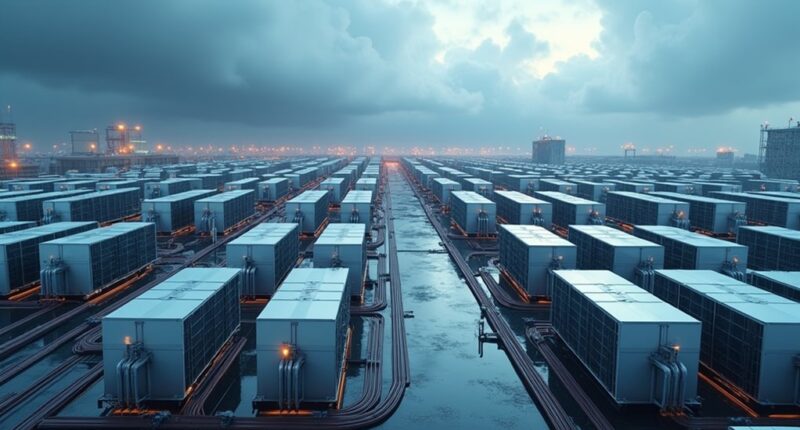As AI adoption accelerates, data centers are demanding more power and water, straining electrical grids and resources across the Atlantic. This surge increases energy bills and causes widespread concerns over environmental impacts and infrastructure delays. Public patience is tested as communities face grid shortages and water scarcity challenges. If you want to understand how these issues unfold and what solutions might emerge, keep exploring the complex relationship between AI growth and our essential resources.
Key Takeaways
- Rising energy demands from AI data centers are causing increased power costs and grid strain across Europe.
- Water-intensive cooling systems threaten regional water supplies, raising environmental and sustainability concerns.
- Infrastructure delays and high costs hinder necessary upgrades to support growing AI computational needs.
- Public patience declines due to rising energy bills and visible strain on electrical infrastructure.
- The environmental impact of AI’s energy and water consumption is intensifying societal and regulatory pressures.

As artificial intelligence continues to advance, data centers are becoming more critical—and more demanding—power sources. You might not realize it, but the rapid growth of AI technologies is pushing the limits of existing infrastructure worldwide. Global electricity demand from data centers is projected to double between 2022 and 2026, largely driven by AI adoption. By 2030, AI is expected to cause a 165% increase in data center power consumption, with some estimates suggesting that, by the mid-2030s, data centers could account for roughly 20% of all global electricity use. Power density per square foot is rising too, from around 162 kW recently to an anticipated 176 kW by 2027, forcing facilities to upgrade cooling and power systems just to keep pace.
AI-driven data centers will soon account for a fifth of global electricity use, demanding faster upgrades and sustainable solutions.
This surge in demand isn’t just a matter of more energy; it also introduces serious environmental concerns. Large AI models, especially generative ones like GPT-4, require enormous amounts of computational power, involving thousands of GPUs and TPUs running continuously for months. This intensive processing greatly increases energy consumption and greenhouse gas emissions, with only a handful of major corporations capable of footing the high costs for hardware, cooling, and energy. Frequent retraining of models and infrastructure inefficiencies further amplify energy use, creating new bottlenecks in grid capacity. In Europe alone, data centers are now driving a rebound in power demand after years of decline, with requests for connection skyrocketing—highlighting how the infrastructure hasn’t kept up with the rapid growth. The increasing energy demands are also straining existing electrical grids, leading to potential supply shortages.
Water use also becomes a vital concern, as cooling systems in data centers rely heavily on water. Training a single AI model like ChatGPT-3 consumed about 5 million liters of water, with a significant portion evaporating during cooling. By 2027, AI-driven water withdrawals could reach up to 6.6 billion cubic meters annually—more than tripling current levels—and threaten to deplete water sources in regions already facing scarcity. This impacts billions of people worldwide, adding another layer of complexity to the environmental footprint of AI.
Meanwhile, the infrastructure to support this growth faces delays and financial hurdles. An estimated $720 billion in global grid investments may be necessary by 2030 just to meet the rising power demands, but permit delays, supply chain issues, and costly upgrades slow progress. In the U.S., efficiency improvements through smarter cooling and hardware design have flattened growth in data center energy use over recent years, but the rapid expansion of AI models continues to challenge these gains. As communities across the Atlantic and beyond grapple with rising energy bills and grid strain, public patience wears thin. The expanding power needs of AI-driven data centers test not only infrastructure but also societal resilience, prompting urgent calls for smarter, more sustainable solutions to keep pace with technological progress.
Frequently Asked Questions
How Do Data Centers Impact Local Energy Grids?
You should know that data centers greatly impact local energy grids by drastically increasing electricity demand, often overloading transmission systems. Their 24/7 operations strain existing infrastructure, causing reliability issues and risking outages. As they rely heavily on fossil fuels, they also contribute to higher carbon emissions. To handle this growth, upgrades are necessary, but delays and costs can make grid stability and environmental goals harder to achieve.
What Are the Environmental Concerns of AI Data Centers?
Imagine a giant, humming beast consuming vast amounts of energy—you’re right to worry. AI data centers raise environmental concerns because they emit huge CO₂ volumes, strain water resources for cooling, and increase air pollution near communities. Their rapid growth risks reversing recent air quality gains and amplifies climate change. If unchecked, these centers could overwhelm local ecosystems and undermine global sustainability efforts, making it essential to adopt cleaner energy and smarter management now.
How Do Data Centers Ensure Data Security and Privacy?
You can guarantee data security and privacy by implementing strong cybersecurity measures like firewalls, intrusion detection systems, and encryption for data both at rest and in transit. You should enforce strict access controls, including multi-factor authentication, and regularly audit your systems for compliance with regulations like GDPR or HIPAA. Additionally, using network segmentation and physical security controls helps protect data from unauthorized access and physical threats.
What Innovations Are Improving Data Center Efficiency?
Aren’t you curious how innovations boost data center efficiency? You can benefit from liquid cooling, immersion cooling, and direct-to-chip solutions that cut energy use and manage high-density workloads. Plus, leveraging renewable energy sources, modular designs, and smart grid integration helps optimize operations and reduce costs. These advancements not only enhance performance but also support sustainability, ensuring your data center runs faster, greener, and more reliably every day.
How Does Public Opinion Influence Data Center Development?
Your opinion influences data center development profoundly. When you support economic benefits like jobs and tax revenue, developers are more likely to seek community approval and invest in new projects. Conversely, concerns about environmental impacts can delay or block developments. Public feedback prompts policymakers and companies to adopt greener technologies and transparent practices, aiming to balance growth with sustainability, ultimately shaping where and how data centers expand in your region.
Conclusion
As you watch these data centers expand across the Atlantic, remember, they’re not just powering AI—they’re pushing the limits of our patience. With energy demands soaring and environmental concerns mounting, it feels like we’re on the brink of a digital marathon. If we don’t find smarter, greener solutions quickly, the strain could be felt worldwide, turning our technological progress into a ticking time bomb. The future depends on balancing innovation with sustainability before things spiral out of control.









